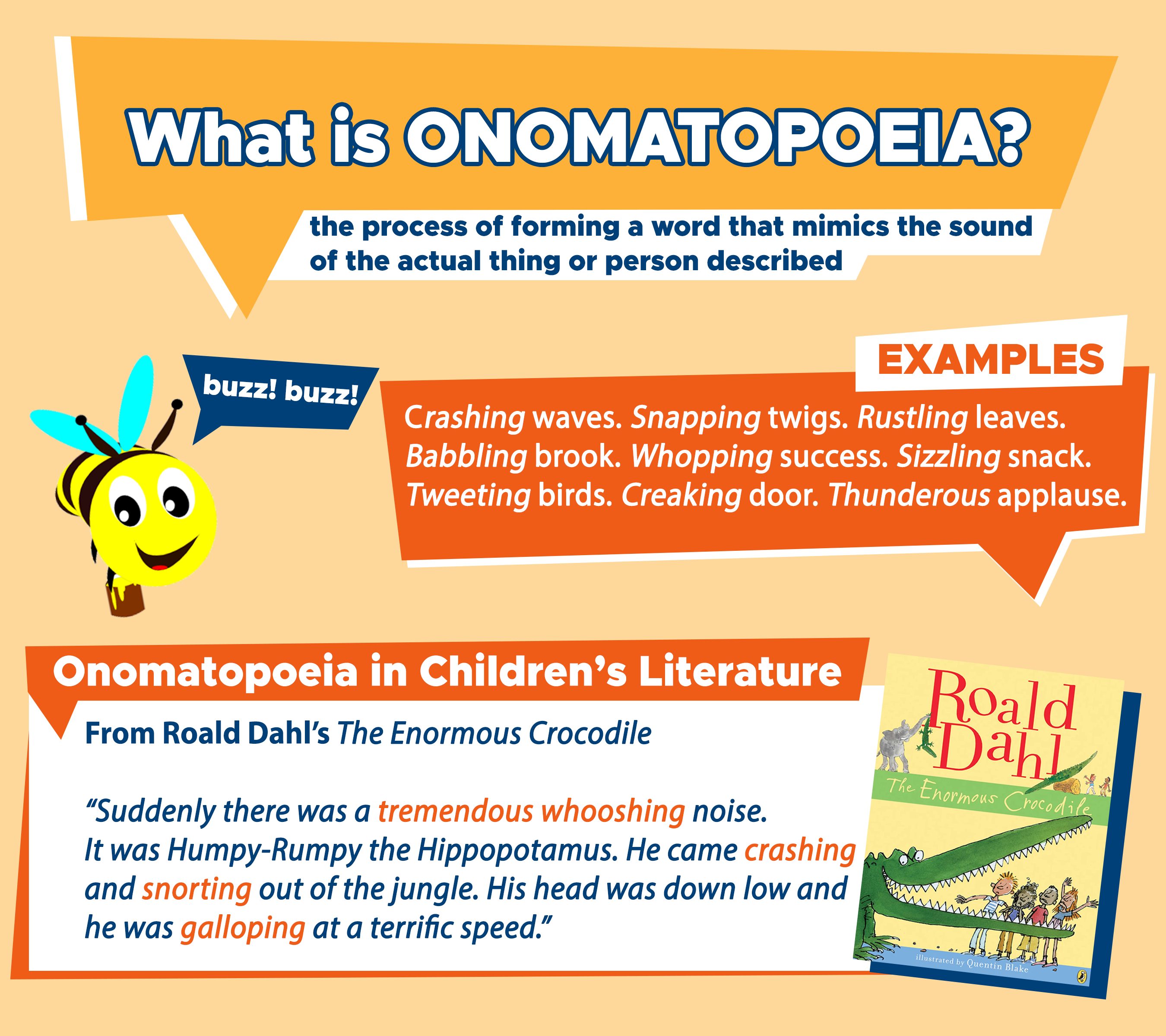From an early age, we’re taught to identify animals by imitating the sound they make. For example, cats go “meow,” dogs say “woof,” “moo” for cows, and so on. The process of forming a word that mimics the sound of a thing or person is called onomatopoeia, which is also the term for the resulting word. Aside from animal sounds, onomatopoeia is alive in the “clip-clop” of a horse’s hooves, the “tic toc” of a clock, and the “woo” of a crowd. It can also be seen in the buzzing of a bee, the humming of a bird, the smashing of a car, and the creaking of a window.

Onomatopoeia in Everyday Speech
Onomatopoeia is a constant part of our everyday conversation without us realizing it. Recall some words that echo what they actually mean and notice how they intensify our stories. Here are a few examples of onomatopoeia in everyday speech.
- Let’s join the people’s clamor for the president’s resignation.
- She was humming while crossing the road and bam! A ginormous truck hit her!
- The rain has been rapping the roof since last night.
- Peace comes with crashing waves, whispering wind, and rustling trees.
- While Derrick cracks an egg and splatters it on the frying pan, Dale crunches his cereals.
Onomatopoeia in Literature
A powerful literary device, onomatopoeia breathes life into literature and pop culture, particularly in comics and advertising. Readers and listeners alike feel a dramatic effect because of the resonating words and sounds.
Here are some examples of onomatopoeia in children’s literature:
- From Jabberwocky by Lewis Carroll
“And, as in uffish thought he stood,
The Jabberwock, with eyes of flame,
Came whiffling through the tulgey wood,
And burbled as it came!
One, two! One, two! And through and through
The vorpal blade went snicker-snack!
He left it dead, and with its head
He went galumphing back.”
Lewis Carroll’s whimsical verse is an excellent example of onomatopoeia in children’s literature. Whiffling gives the readers an idea of the Jabberwock’s quick skidding through the woods, while burble creates a bubbling sound referring to the noise made by the creature’s movement. Snicker-snack brings to mind a slashing knife, while Galumphing sounds like a combination of gallop and thump – a movement peculiar to the Jabberwock. The readers’ imagination is fueled by the onomatopoeic words because they invite them to a thrilling adventure.
- From The Enormous Crocodile by Roald Dahl
“Suddenly there was a tremendous whooshing noise. It was Humpy-Rumpy the Hippopotamus. He came crashing and snorting out of the jungle. His head was down low and he was galloping at a terrific speed.”
Roald Dahl gives birth to new worlds with his wordplay. Notice how the phrase tremendous whooshing builds an image of Humpy-Rumpy’s heavy movement in the water, while the words crashing and snorting send an idea of how he sounds. Finally, galloping makes clear that Humpy-Rumpy is in a hurry. His clever use of onomatopoeia glues readers to every page.
Onomatopoeic Words in Poetry
Here’s an example of onomatopoeia in poetry.
- From Running Water by Lee Emmett
“water plops into pond
splish-splash downhill
warbling magpies in tree
trilling, melodic thrill”
Readers are transported to the scenic setting defined in the verse because of Lee Emmett’s use of onomatopoeia.
Related Reading: Alliteration – Creating Rhythm with Words
Onomatopoeia in Pop Culture
Superhero comics brim with onomatopoeic words, such as “Pow!” “Wham!” “Bham!” “Whiz!” and “Bang!” Comic writers even make up words like “Brrrt” and “Blap” which make the material more engaging.
After all, onomatopoeia is a figurative language unbounded by the semantic meaning of the word. It can be pulled from the actual sound of the thing being described, such as the “Whoosh!” of a waterfall.
Here are examples of onomatopoeia in branding and advertising.
- Pop Pop! (firecracker brand)
- “Snap, crackle, pop” (Rice Krispies cereal)
- Splash Island (Resort)
- Nestle Crunch
- Zoom Zoom Zoom (Mazda’s old slogan)
When to Use Onomatopoeia
Onomatopoeia injects emotion and energy into speech and writing. Use it to cut boredom and spark the imagination of your readers, but make sure to use it sparingly so as not to cause confusion. Also, because onomatopoeia often uses made-up words, think twice before using it in formal writing. You don’t want your research paper or dissertation to sound like a page from a comic, but you do want it to enhance your creative writing.
Thank you for reading. We hope it’s effective! Always feel free to revisit this page if you ever have any questions about onomatopoeia.

